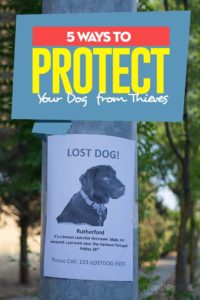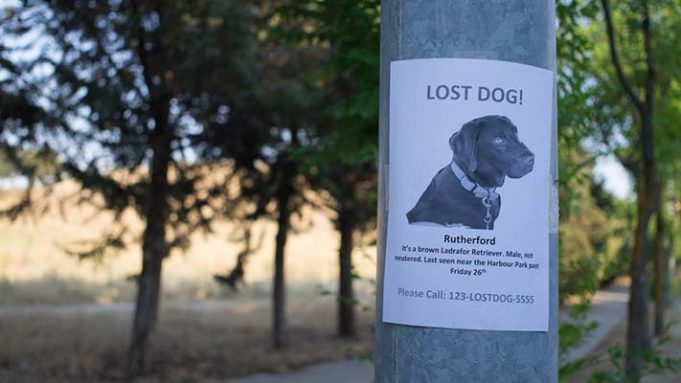As nice as it is to be able to let your dog out into the yard while you get ready for work, it’s can be an extremely risky thing to do. Dog thievery is a real threat and must be viewed as such; the number of dog thefts have rose by 33% over the last few years. We all go about our daily lives thinking it will never happen to us. However, it’s always possible for a stranger to come along and snatch your pup when no one’s around.
If you're a pet owner, protecting your dog from being stolen is something you need to be aware of, and take the necessary precautions to prevent it from happening. Of the four million pets that go missing each year, two million are stolen according to the data provided by ASPCA. It might surprise you, but dogs are becoming more valuable to thieves, and gangs are now developing new techniques for stealing dogs from their owners. See how dog thieves operate:
For anybody afraid of their dog being stolen, here's how to not let your pup end up as one of those above mentioned numbers.
1. Give Your Dog Proper Identification
Dogs that are stolen sometimes end up escaping or being dumped in another location, which is good news if there’s any hope of getting your dog back. Even though the potential thief can easily remove a dog's collar and tags, there are other methods of identifying your dog.
Microchips and Tattoos
If Animal Control or a good Samaritan does end up finding your dog, you’ll want them to be able to locate you as well, preferably quickly. Microchipping is what you need, so go the veterinarian and get your pet a microchip; they’re the size of a grain of rice and are inserted into the dog's neck, just underneath the top layer of skin.
When scanned, the chip will provide both the name and description of your dog, along with your contact information, such as your name and address. You can also have your social security number, driver’s license, and state information tattooed on your dog’s inner thigh. However, dog tattoos aren't always a possible option, especially since some states like New York have banned tattooing your pet.
Keep Information Up to Date
Overall, microchipping your pet is much better. So if you do decide to get a microchip, remember to update it once a year so that all the information stays current. To be on the safe side, you can easily update it every single month, or as often as you want to with the online account that it comes with. It's very quick and easy.
2. Breeds That Are Most Likely to Be Stolen
 People steal dogs for a number of reasons, but the primary motivator is of course money. Breeds such as the Maltese, French Bulldog, Yorkshire Terriers, and English Bulldog are often stolen and sold to commercial breeders or unsuspecting buyers. Some breeds and even specific dogs could be worth thousands of dollars, as this example illustrates.
People steal dogs for a number of reasons, but the primary motivator is of course money. Breeds such as the Maltese, French Bulldog, Yorkshire Terriers, and English Bulldog are often stolen and sold to commercial breeders or unsuspecting buyers. Some breeds and even specific dogs could be worth thousands of dollars, as this example illustrates.
Since on average the above breeds (and some others) sell for about two thousand dollars give or take, they make easy targets for dog thieves who want to get a quick buck. Larger breeds such as the American Bull Terrier, Staffordshire Terrier, and other dogs that resemble the bully breeds are often stolen for fighting purposes.
Dog Fighting Rings Don’t Discriminate
The tragic underground blood sport of dog fighting draws in millions of dollars per year, and is a major reason why advertising your dog as “free to good home” online. This is also a serious problem when shelters become overcrowded, as “free adoption events” tend to draw in the wrong people. If you own a breed that is likely to be a victim of theft, don’t take the risk of losing them.
Keep in mind that it doesn’t matter if you have a Pit Bull, a Yorkie, or even a cat; dog fighters will take just about any loose animal they can find and use them as bait for fighting dogs. Even if you live in the nicest neighborhood on the planet, the wrong people will inevitably look for easy victims wherever they can be found. Remain vigilant, no matter where you live or what kind of dog you have.
3. Spay and Neuter, Especially Designer Dogs
Getting your dog fixed helps to prevent them from getting certain kinds of cancers, keeps away unwanted suitors, and reduces the likelihood that they’ll be taken from you. People who believe you have a “purebred,” whether it’s true or not, have an incentive to steal your dog. Since people are often willing to pay hundreds of thousands of dollars for designer dogs, it’s the perfect opportunity for them to make some quick cash.
Not Everyone Loves Your Dog as Much as You Do
As horrible as that sounds, it’s the reality that we face everyday. To some people, canines are nothing more than breeding machines that prevent them from having to get a job and work. What for, when they can steal your pet, sit back, relax, and pump out puppies in puppy mills. If your pet is sterile and unable to reproduce, they are far less likely to be stolen from you because they'd be useless in a puppy mill.
4. Watch Out for Strangers (who ask questions)
 Unfortunately, not everyone we speak to is trustworthy or has the best intentions for you and your dog. What seems like a friendly conversation may just be someone who is surveying you for information about your dog and/or your home. If someone ever comes up and begins to ask about what you paid for your dog, whether or not you’d be willing to sell, or offers you some type of compensation to breed your dog, stay on alert. In the UK, thieves on lookouts are talking to dog owners, scouting the locations and then marking good spots with letter “K” as a new method for stealing dogs.
Unfortunately, not everyone we speak to is trustworthy or has the best intentions for you and your dog. What seems like a friendly conversation may just be someone who is surveying you for information about your dog and/or your home. If someone ever comes up and begins to ask about what you paid for your dog, whether or not you’d be willing to sell, or offers you some type of compensation to breed your dog, stay on alert. In the UK, thieves on lookouts are talking to dog owners, scouting the locations and then marking good spots with letter “K” as a new method for stealing dogs.
Get to Know the People in Your Neighborhood
A responsible, reputable breeder doesn’t walk up and down the streets looking for a mating partner for their pet. Don’t conceal information about your daily habits, work schedule, and how often your pet is home alone to strangers. This is a major red flag, and could pose as a threat to you, your dog, and your family should they attempt to break in. Also, thieves themselves say that Neighborhood Watches work, and are a major deterrent for criminals.
5. Have Signs on Hand
 On the off chance that your dog does end up stolen or missing, the last thing you want is to be scrambling for resources in a panic. Before anything bad ever happens, make signs that include your dog’s physical description, age, gender, name, your contact information, and any other pertinent information. Have them laminated and keep them in a safe place where you can find them immediately if something bad happens.
On the off chance that your dog does end up stolen or missing, the last thing you want is to be scrambling for resources in a panic. Before anything bad ever happens, make signs that include your dog’s physical description, age, gender, name, your contact information, and any other pertinent information. Have them laminated and keep them in a safe place where you can find them immediately if something bad happens.
The faster you get your “Missing Dog/Stolen Dog” posted up and make other people aware, the faster you’ll be able to find your dog as the trail could still be fresh. At least you might get a description of the person who have taken your pooch from you. If the potential thief knows that good Samaritans are keeping their eyes peeled, it probably won’t take very long before your pup turns up somewhere.
READ NEXT: Top 10 Best Wireless Dog Fences to Keep Your Dog Out of Trouble













